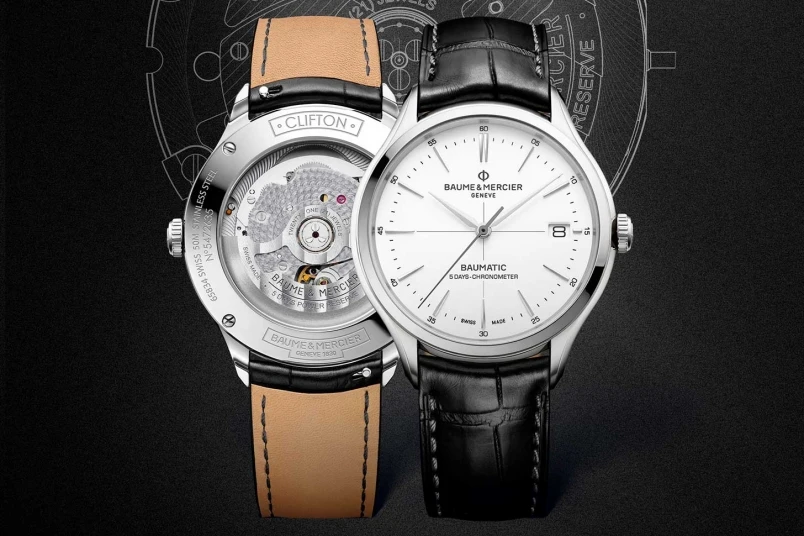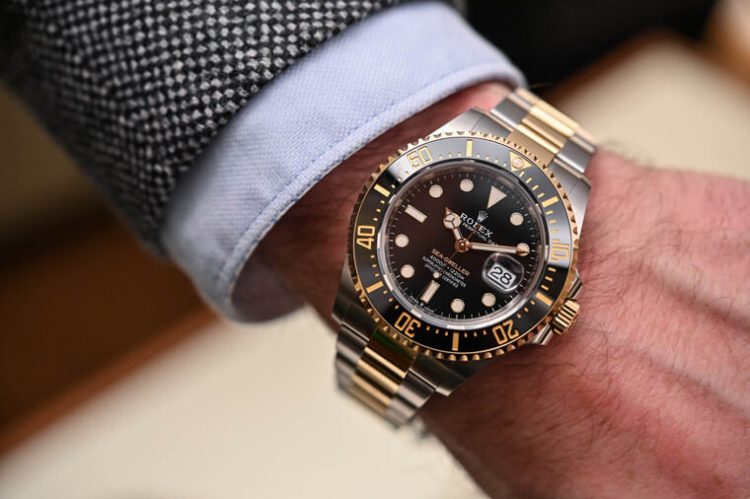Introduction
Luxury watches are more than just timepieces—they are statements of precision, craftsmanship, and legacy. Among the most prestigious names in Swiss horology, Rolex and Baume & Mercier stand as two of the most well-regarded brands in the watch industry. Each of these brands has its own distinct history, philosophy, and approach to watchmaking, yet both have earned their place as icons in the world of luxury timepieces.
Rolex, founded in 1905 by Hans Wilsdorf and Alfred Davis, revolutionized the world of watches with innovations in precision, durability, and luxury. Known for its iconic Oyster case, self-winding movements, and timeless designs, Rolex has become synonymous with prestige, success, and adventure.
On the other hand, Baume & Mercier, established in 1830 by the Baume brothers in the heart of the Swiss Jura mountains, represents the epitome of elegant, refined craftsmanship. Though perhaps less widely recognized than Rolex, Baume & Mercier’s dedication to fine watchmaking, with a focus on sophisticated design and precision, has earned it a loyal following worldwide.
In this comprehensive article, we will explore the histories and unique contributions of both brands, tracing their evolution from humble beginnings to the iconic status they hold today. By examining their founding, key innovations, design philosophies, and cultural impacts, we’ll gain a deeper understanding of what has made Rolex and Baume & Mercier stand the test of time as two of the finest watchmakers in history.
Chapter 1: The History and Legacy of Rolex Watches
1.1 The Founding of Rolex
Rolex was founded in 1905 by Hans Wilsdorf and his brother-in-law Alfred Davis in London, under the name “Wilsdorf & Davis.” The company initially focused on importing Swiss movements and placing them in high-quality cases made by other manufacturers. The goal was to create affordable yet reliable wristwatches, a novel concept at the time since most watches were pocket watches.
- The Name Rolex: The name “Rolex” was coined in 1908, as Wilsdorf sought a name that was short, easy to pronounce in any language, and could fit easily on a watch dial. Rolex quickly became associated with precision and reliability, and the company established a reputation for delivering watches that stood out for their high quality.
1.2 The Birth of the Rolex Oyster Case: A Game-Changing Innovation
One of the pivotal moments in Rolex’s history came in 1926 when it introduced the Oyster case, a revolutionary waterproof design that would set the brand apart from its competitors. The Oyster case was the world’s first waterproof wristwatch case, featuring a hermetically sealed design with a screw-down crown and case back that prevented water, dust, and dirt from entering the movement.
- Rolex and Mercedes Gleitze: In 1927, the brand made headlines when Mercedes Gleitze, a British swimmer, wore a Rolex Oyster during her attempt to swim across the English Channel. Although her initial attempt failed, the watch’s resilience was proven after the successful swim in cold waters, reinforcing Rolex’s reputation for durability and precision.
1.3 The Rise of Rolex in the Mid-20th Century
Following the success of the Oyster case, Rolex continued to innovate, introducing groundbreaking features and models throughout the 1930s, 1940s, and 1950s. These years solidified Rolex’s reputation as a manufacturer of not just durable but also stylish, high-performance watches.
- The Perpetual Movement (1931): Rolex introduced the self-winding movement in 1931 with the creation of the Rolex Oyster Perpetual. This automatic movement was a breakthrough in watchmaking, eliminating the need for manual winding. The movement utilized a rotor that turned with the wearer’s wrist, providing continuous energy to the watch.
- The Submariner (1953): Rolex’s Submariner was introduced in 1953, a diver’s watch designed to withstand the extreme pressures of deep-sea exploration. Featuring a rotatable bezel for tracking dive times and a water resistance rating of 300 meters, the Submariner became an icon in both diving and watchmaking circles.
- The Datejust (1945): Another milestone was the Datejust, introduced in 1945 to mark Rolex’s 40th anniversary. It was the first wristwatch to feature a date window that automatically changed at midnight, setting a new standard for utility and convenience in luxury watches.
1.4 Rolex and the World of Exploration
Rolex’s dedication to creating watches that could withstand the most challenging environments led to strong associations with exploration and adventure. The brand’s partnership with explorers, athletes, and adventurers has had a lasting cultural impact.
- Rolex and Mount Everest: Rolex played a key role in Sir Edmund Hillary’s and Tenzing Norgay’s historic first ascent of Mount Everest in 1953. Both wore Rolex Oyster Perpetual watches, and the brand’s involvement in this monumental achievement became an enduring symbol of Rolex’s connection to extreme exploration.
- Rolex and the Deep Sea: Similarly, Rolex’s Deepsea Special watch was famously attached to the exterior of Jacques Piccard’s bathyscaphe in 1960, when it descended to a world-record depth of over 10,000 meters in the Mariana Trench, further cementing its reputation for resilience and durability.
1.5 Rolex’s Enduring Influence on Watchmaking and Culture
Today, Rolex is considered the pinnacle of luxury, prestige, and reliability. Its watches are prized by collectors, athletes, and celebrities alike, and the brand continues to innovate in areas like precision, durability, and design. The Rolex crown logo is now an indelible symbol of success, and the brand remains the undisputed leader in luxury timepieces.
- Rolex in Popular Culture: Over the decades, Rolex watches have appeared in countless films, including the James Bond series, where the Rolex Submariner became the watch of choice for 007. Celebrities such as Paul Newman, Roger Federer, and Tiger Woods have also been strong ambassadors for the brand, further contributing to its association with success, power, and achievement.

Chapter 2: The History and Legacy of Baume & Mercier Watches
2.1 The Founding of Baume & Mercier
Founded in 1830 in Les Bois, Switzerland, by the Baume brothers, Louis-Victor and César, Baume & Mercier began as a small watchmaking business in the Jura Mountains, where it quickly earned a reputation for craftsmanship and precision. The brand was known for producing high-quality pocket watches that were both elegant and reliable.
- Baume & Mercier and Global Expansion: By the 1850s, the Baume brothers had established a network of watchmaking workshops in Switzerland and set their sights on international markets, particularly in London and Hong Kong. The company’s expansion helped solidify its place as one of the finest watchmaking houses of the 19th century.
2.2 The Evolution of Baume & Mercier’s Timepieces
Over the decades, Baume & Mercier continued to innovate and refine its watchmaking techniques, gaining recognition for its elegant designs and Swiss precision.
- The Baume & Mercier Signature (1890s): The company’s early success was built on its signature precision and elegant design. Baume & Mercier watches, crafted from gold and silver, were sought after by royalty and the elite. Their intricate detailing and design placed them in the ranks of some of the finest timepieces in Europe.
- The Launch of the “Riviera” (1973): A pivotal moment in Baume & Mercier’s history came in the 1970s when the brand launched the Riviera collection. The Riviera was a bold departure from the more classical designs Baume & Mercier had previously favored, featuring an octagonal bezel and a sporty, modern design. It was a direct response to the changing tastes of watch buyers during the rise of the Quartz Crisis.
2.3 Baume & Mercier and the Art of Watchmaking
Baume & Mercier’s commitment to excellence in Swiss watchmaking continued throughout the 20th century, and the brand became a trusted name among those who valued elegance and craftsmanship. The brand’s focus on delivering refined timepieces earned it numerous accolades over the years.
- The Clifton Collection (2013): In 2013, Baume & Mercier launched the Clifton collection, which was a tribute to the brand’s long history. The Clifton combined classic design with modern sophistication, and quickly became one of the brand’s most successful and well-known collections. The Clifton Baumatic introduced in 2018 featured Baume & Mercier’s in-house movement, solidifying the brand’s reputation for precision and innovation.
2.4 Baume & Mercier’s Impact on Modern Watch Culture
Though not as globally dominant as Rolex, Baume & Mercier has made a significant impact in the world of luxury watches. The brand continues to be a favorite among those who appreciate refined craftsmanship and understated elegance.
- Baume & Mercier in Popular Culture: The brand has maintained a strong presence in the world of high-end watchmaking, particularly among connoisseurs of fine watches. Baume & Mercier’s focus on sophisticated yet affordable luxury has made it a go-to brand for those looking to invest in a timeless timepiece without the ultra-premium pricing of other Swiss giants.
Chapter 3: Comparing the Legacy of Rolex and Baume & Mercier
3.1 Rolex: The Epitome of Luxury and Innovation
Rolex has become synonymous with the idea of luxury, precision, and success. It represents the pinnacle of craftsmanship and is associated with achievement, both in sports and business. The brand’s legacy is built upon its technical innovations, such as the Oyster case, Perpetual movement, and the Explorer’s watch.
3.2 Baume & Mercier: A Commitment to Elegance and Precision
While Rolex focuses heavily on prestige and innovation, Baume & Mercier has carved out its own niche by emphasizing elegance, timeless design, and Swiss craftsmanship. The brand appeals to those who appreciate subtle luxury, understated design, and a rich historical heritage.
Conclusion
Both Rolex and Baume & Mercier represent the pinnacle of Swiss watchmaking, though they approach luxury and craftsmanship from different perspectives. Rolex, with its bold innovations and commitment to precision, has created a global brand that is synonymous with status and success. In contrast, Baume & Mercier focuses on creating elegant, sophisticated timepieces that honor tradition while embracing modernity.
Together, they illustrate the range of excellence found in Swiss watchmaking, each contributing uniquely to the legacy of horology. Whether you prefer the adventurous spirit of Rolex or the refined elegance of Baume & Mercier, both brands have proven that true luxury lies not only in a watch’s aesthetics but in the heritage and craftsmanship behind it.





































